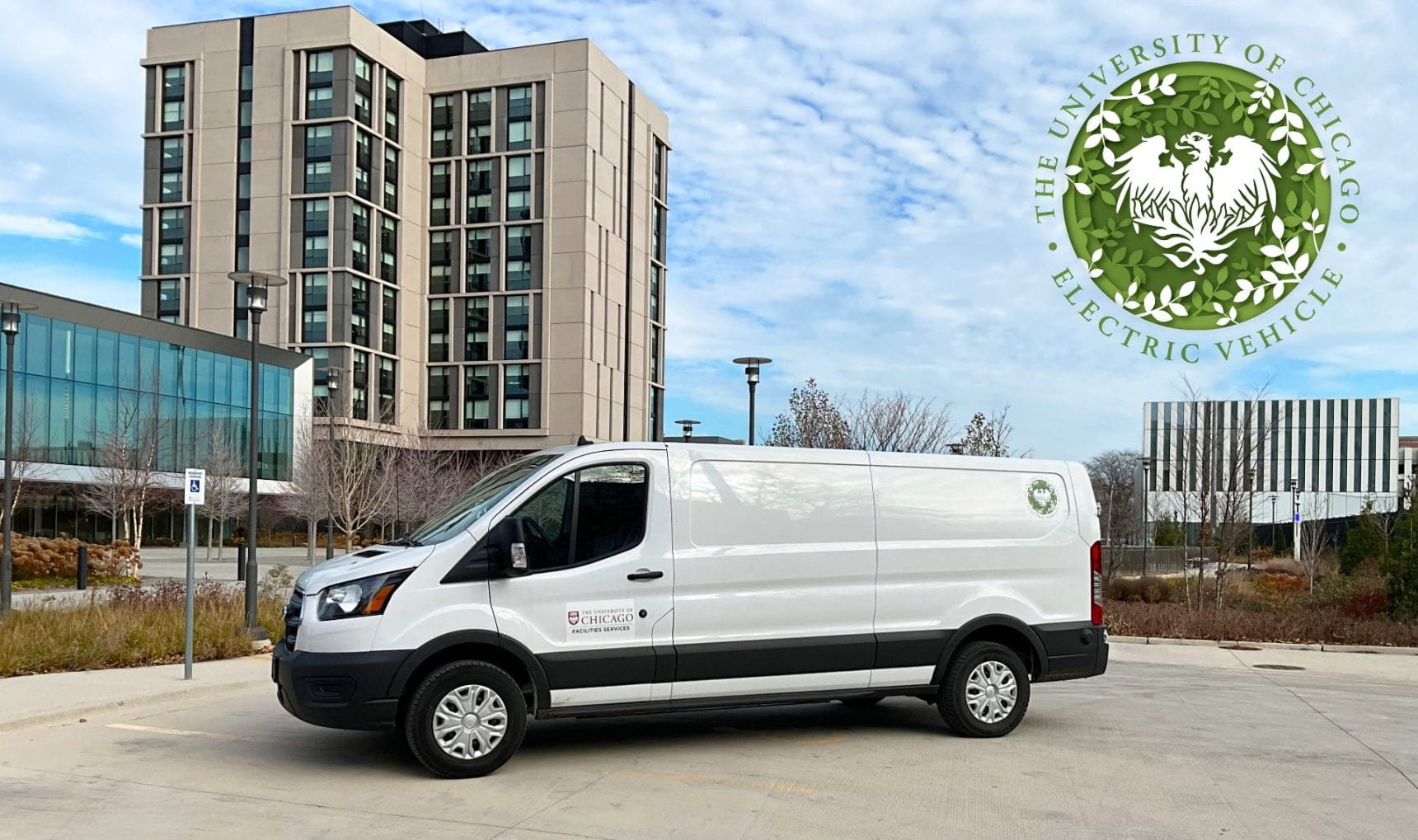By Maureen McMahon
A new era is underway for the University of Chicago. Visitors to campus can now see four white all-electric Ford E-Transit vans making their rounds, each emblazoned with a bright, leafy-green UChicago Phoenix. The logos, designed by Nathan Bartlett of Facilities Services, are rolling displays of the beginning of the transition of some Facilities Services’ gasoline-powered fleet vehicles to electric or hybrid electric.
The University of Chicago has a goal to reduce campus absolute greenhouse gas emissions by 50% by 2030, and as a part of that goal, aims to convert 60% of the University fleet by 2030.
University vehicles are eligible to be replaced when they reach the end of life, which is usually ten years since the nature of the work is hard on the vehicles. These four vans are the first among 64 vehicles in the Facilities Services fleet to be replaced.
“We make a careful evaluation of what is available in the electric or hybrid vehicle market to meet the needs of the University,” said John D’Angelo, assistant vice president of Facilities Operations. “UChicago is always looking for ‘AND’ solutions rather than ‘OR’ solutions. How do we get the best value AND the safest opportunity for our people to support the University’s academics and research missions AND impact the climate AND reduce the need to have on-campus fuel stations?”

The Ford E-Transits were chosen because they are ideal for short trips and hauling heavy loads. The carpenters who use them have outfitted them to be rolling workshops that charge tools, maneuver easily, and drive silently. For one driver, the van replaces a van he used for 20 years, and he reported that he feels enthusiastic and proud to work with a sustainable vehicle.
“In the next five years, 47% of the gasoline vehicles in the fleet will be at the end of life,” said Mark Meyers, director of Building Trades for Facilities Operations, who manages purchases. He and D’Angelo monitor the market to see where there could be a fit.
“Currently, pickup trucks that comprise the majority of fleet needs do not have immediate replacements on the market; the new EVs are designed for range and we need higher torque to be able to plow snow,” said D’Angelo.
Infrastructure to charge these vehicles was installed in August at the Facilities Services building on South Cottage Grove Avenue. Trenches had to be dug around the parking lot perimeter to accommodate underground electrical distribution to support the new EV charging stations. The system is connected to a dedicated onsite generator service pad and cabinet for utility metering. Existing ComEd distribution in the alley powers the operation.
Robert Bandura, chief electrical engineer for Facilities Operations, led the design and installation of the service network. “The University partnered with the firm Affiliated Engineers, Inc., for the engineering and design bid packages. Canino Electric was responsible for the electrical installation and testing and commissioning of the system,” he said.
The E-Transits can now nose up to two aluminum Level-2 EvoCharge stations. Since most trips are in or around campus, charging the vans happens about every four days.
The installation of a total of 10 charging stations is scheduled to be completed in early 2024, with plans to include 25 additional stations in the future around the lot. This distribution system will eventually charge 60+ fleet vehicles.
“Now that we have this EV charging infrastructure in place, it makes those conversations about what vehicles to get easier to have,” said D’Angelo.
There will be three dual charging stations added around campus for the fleet, with one location already determined to be behind the International House.
When will the University begin to see cost savings? The totals will be revealed by the pump and the power meter. UChicago has its gas station permitted to dispense up to 10,000 gallons per month, and typically 9,000 gallons per month are used. The team is eager to see dispensing go down, and potentially the gas station can become available as a buildable site for future academic and research buildings. “The financial benefit of electrifying the fleet will be revealed in the years to come as more e-vehicles cycle in and annual comparisons can be made,” said Meyers.
“We want Facilities Services to be proof of concept that other UChicago units can replace end-of-life vehicles with electric vehicles,” said D’Angelo. “A lot of people pushing in the same direction has gotten us this far and will continue to push us in the right direction.”
To learn more about the University of Chicago’s sustainability goals and emissions reduction progress, visit Reporting on the Office of Sustainability website.

